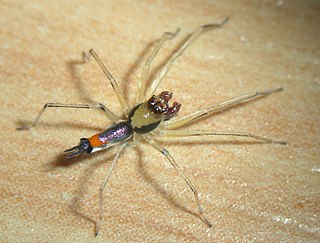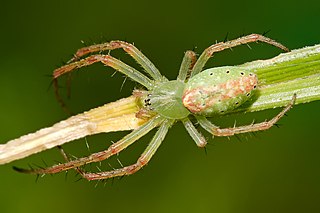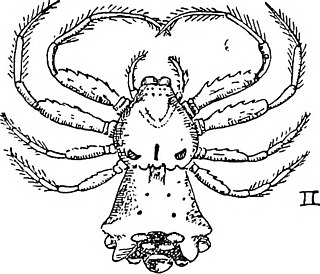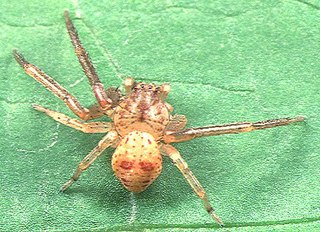
The sac spiders of the family Clubionidae have a very confusing taxonomic history. Once, this family was a large catch-all taxon for a disparate collection of spiders, similar only in that they had eight eyes arranged in two rows and conical anterior spinnerets that touched, and were wandering predators that built silken retreats, or sacs, usually on plant terminals, between leaves, under bark, or under rocks. These are now recognized to include several families, some of which are more closely related to the three-clawed spiders, like lynx and wolf spiders, than to Clubionidae and related families.

The bimaculated lark breeds in warm temperate countries eastwards from Turkey into Central Asia. It is the eastern counterpart of its relative, the calandra lark.

Afromarengo is a genus of jumping spiders that was first described by S. P. Benjamin in 2004. The name is derived from "Africa" and the genus Marengo. The genus Indomarengo is similarly named.

Asemonea is a genus of jumping spiders that was first described by Octavius Pickard-Cambridge in 1869.
Salpesia is a genus of jumping spiders that was first described by Eugène Louis Simon in 1901.
Spilargis is a monotypic genus of jumping spiders containing the single species, Spilargis ignicolor. It was first described by Eugène Louis Simon in 1902, and is found only in Papua New Guinea and on the Moluccas. A subspecies, Spilargis ignicolor bimaculata, is found on the Moluccas. The name is a combination of the Ancient Greek roots spil- "spot" and arg- "shining". The species name is Latin for "the color of fire". bimaculata is Latin for "with two spots".
Gelotia is a genus of jumping spiders that was first described by Tamerlan Thorell in 1890.

Cyrtophora, the tent-web spiders, is a genus of orb-weaver spiders first described by Eugène Simon in 1895. Although they are in the "orb weaver" family, they do not build orb webs. Their tent-like, highly complex non-sticky web is sometimes considered a precursor of the simplified orb web. These webs are aligned horizontally, with a network of supporting threads above them. These spiders often live in colonies. Females have a body length of mostly about 10 millimetres (0.39 in) long. Some members, including Cyrtophora cicatrosa, exhibit the ability to change colour rapidly.

Lomographa bimaculata, the white-pinion spotted, is a species of geometer moth. It belongs to the large geometer moth subfamily Ennominae, and therein to the tribe Baptini. It is – under its junior synonym – the type species of its genus Lomographa. It is also the type species of Bapta, a junior objective synonym of Lomographa and the namesake of the Baptini. The species was first described by Johan Christian Fabricius ion 1775.

Glycymeris bimaculata is a marine bivalve mollusc in the family Glycymerididae.

Phrynarachne is a genus of crab spiders first described by Tamerlan Thorell in 1869.
Nusatidia is a genus of Asian sac spiders first described by Christa L. Deeleman-Reinhold in 2001.
Metanapis is a genus of araneomorph spiders in the family Anapidae, first described by Paolo Brignoli in 1981.
Leptopicia is a genus of spiders in the family Corinnidae. It was first described in 2015 by Raven. As of 2017, it contains only one species, Leptopicia bimaculata, found in Australia.

Neottiura is a genus of comb-footed spiders that was first described by Anton Menge in 1868.

Pharta is a genus of crab spiders family first described by Tamerlan Thorell in 1891.
Christa Laetitia Deeleman-Reinhold is a Dutch arachnologist. She graduated from the Leiden University in 1978. She specializes in spiders from Southeast Asia and Southern Europe, particularly cave-dwelling and tropical spiders. She donated a collection of about 25,000 Southeast Asian spiders, the largest collection of Southeast Asian spiders in existence, to the Naturalis Biodiversity Center in Leiden, The Netherlands. In addition to numerous articles, she has written the book Forest Spiders of South East Asia (2001). She is married to arachnologist Paul Robert Deeleman, with whom she has co-authored multiple publications.

Diplecogaster bimaculata, the two-spotted clingfish, is a species of fish in the family Gobiesocidae found in Black Sea, Mediterranean Sea and Atlantic Ocean where it is found on rocks and among seagrass or shell beds.

Neottiura bimaculata is a species of cobweb spider in the family Theridiidae. It is found in North America, Europe, Turkey, Caucasus, Russia (Sibiria), Central Asia, China, and Japan.











